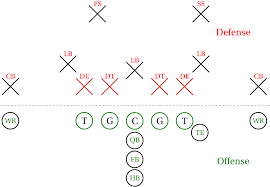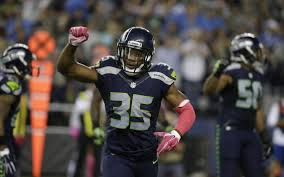Bradley Moss
Kinesiology 5301
The Secondary
 In this article we will look at the defensive back position in football. To start will discuss how many defensive backs there and where they actually line up on the defensive side of the ball behind the linebackers in football. In a standard 4-3 defense there are 4 defensive backs on the field at a time. From left to right they line up as follow. Left corner back, free safety, strong safety, and right corner back. There can also be a fifth defensive back that can come in. They will usually replace a linebacker. This position is called a nickel corner back.
In this article we will look at the defensive back position in football. To start will discuss how many defensive backs there and where they actually line up on the defensive side of the ball behind the linebackers in football. In a standard 4-3 defense there are 4 defensive backs on the field at a time. From left to right they line up as follow. Left corner back, free safety, strong safety, and right corner back. There can also be a fifth defensive back that can come in. They will usually replace a linebacker. This position is called a nickel corner back.
Defensive Back Responsibilities
 1The defensive back position responsibilities will vary depending on the position. Starting with the corner back they are covering the wide receivers. They will be normally in a press coverage and they will stay with the receivers through the entire play in hopes of deflecting or intercepting the ball thrown by the quarterback. Next we will look at the safety position. Their primary responsibility is provide support for the corner backs. A free safety will normally either anticipate a short pass or play deep and provide help for the corners for a long deep pass. Not only will the strong safety do the same task they can also help in run support.
1The defensive back position responsibilities will vary depending on the position. Starting with the corner back they are covering the wide receivers. They will be normally in a press coverage and they will stay with the receivers through the entire play in hopes of deflecting or intercepting the ball thrown by the quarterback. Next we will look at the safety position. Their primary responsibility is provide support for the corner backs. A free safety will normally either anticipate a short pass or play deep and provide help for the corners for a long deep pass. Not only will the strong safety do the same task they can also help in run support.
Key Statistics for defensive back
Like in previous blogs will discuss the key statistics for the defensive back.
Tackle - This stat can be achieved when the defensive back tackles the ball carrier to the ground
Force Fumble - The stat can be achieve when a defensive back strips the ball from the ball carrier before the ball carrier is considered down.
Fumble Recovery - This stat is achieved when the defensive back recovers a fumble committed by the other team.
Interception - This stat is achieved when the defensive back catches a pass from the other team's quarterback.
Pass deflection - This can be achieved when a defensive back knocks down the pass that is thrown by the quarterback.
Conclusion
In conclusion after reading this article, I hope the reader will have a greater understanding of what a defensive back is and their responsibilities.
References
Great job describing the secondary Bradley. Secondary players have a really tough job and you did a excellent job laying out why they are generally the best athletes on the field. Depending on defensive philosophy and personnel strengths/weaknesses, some programs choose to designate Corners as either Boundary or Field Corners. There are pros and cons to this approach, but it's worth noting that corners don't always line-up on the same side of the field. It's also worth noting how the Safeties line-up. Most, but not all programs, designate their safeties as either the Strong Safety or the Free Safety. The Strong Safety is typically the bigger and more physical of the two. He will generally line-up against the offensive formation strength and will be the first safety tasked to provide run support and/or underneath coverage help. The Free Safety, on the other hand, is typically smaller in stature (he could be taller and thinner than the strong safety) and less physically imposing. The Free-Safety must be capable of taking away the deep middle of the field (certainly between the hashes but preferably between the numbers). The best Free-Safeties are smart players and are often referred to as the Quarterback of the secondary, responsible for making sure all players in the secondary are line-up correctly. Again, great job Bradley.
ReplyDeleteGreat job describing the secondary Bradley. Secondary players have a really tough job and you did a excellent job laying out why they are generally the best athletes on the field. Depending on defensive philosophy and personnel strengths/weaknesses, some programs choose to designate Corners as either Boundary or Field Corners. There are pros and cons to this approach, but it's worth noting that corners don't always line-up on the same side of the field. It's also worth noting how the Safeties line-up. Most, but not all programs, designate their safeties as either the Strong Safety or the Free Safety. The Strong Safety is typically the bigger and more physical of the two. He will generally line-up against the offensive formation strength and will be the first safety tasked to provide run support and/or underneath coverage help. The Free Safety, on the other hand, is typically smaller in stature (he could be taller and thinner than the strong safety) and less physically imposing. The Free-Safety must be capable of taking away the deep middle of the field (certainly between the hashes but preferably between the numbers). The best Free-Safeties are smart players and are often referred to as the Quarterback of the secondary, responsible for making sure all players in the secondary are line-up correctly. Again, great job Bradley.
ReplyDelete